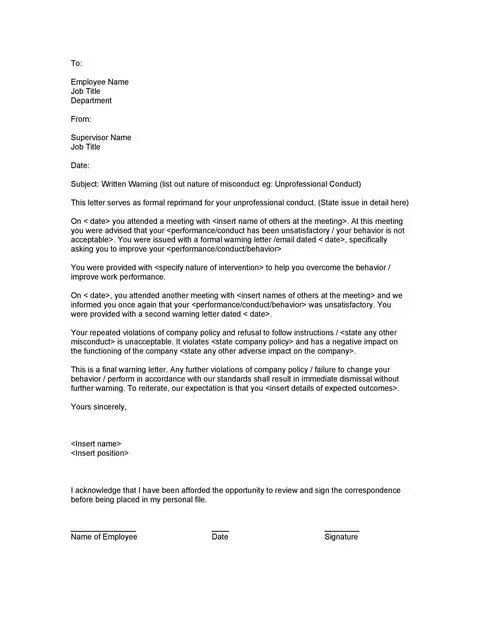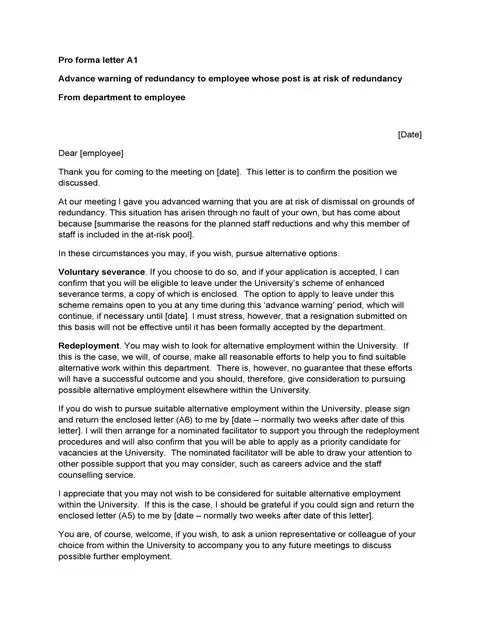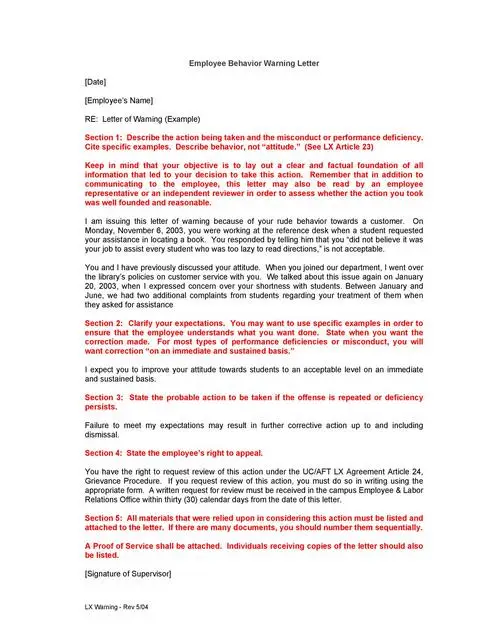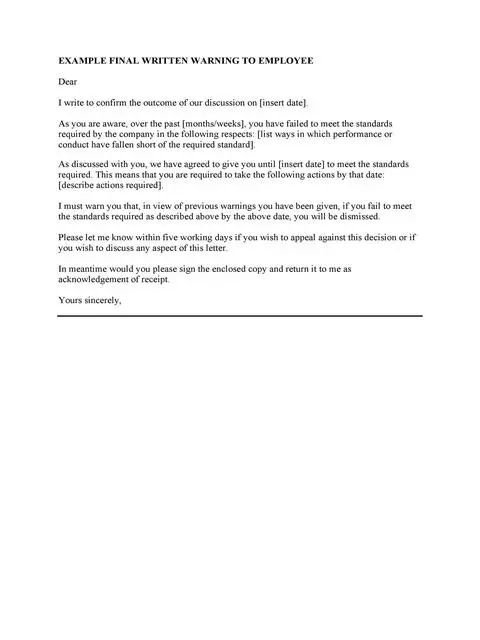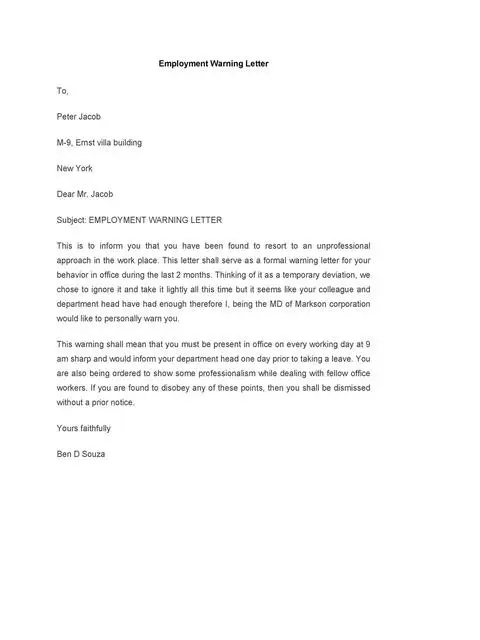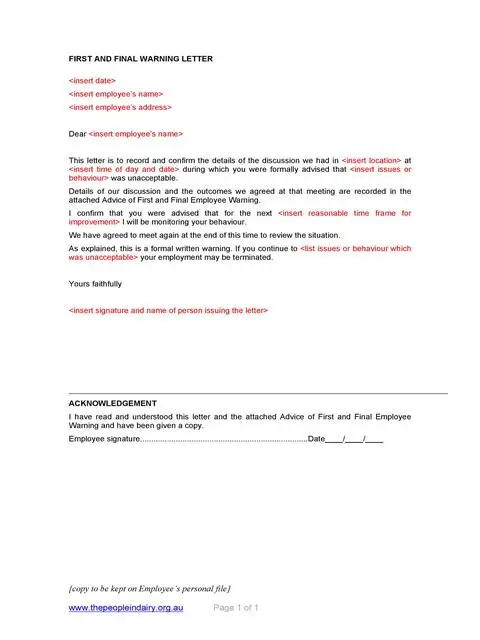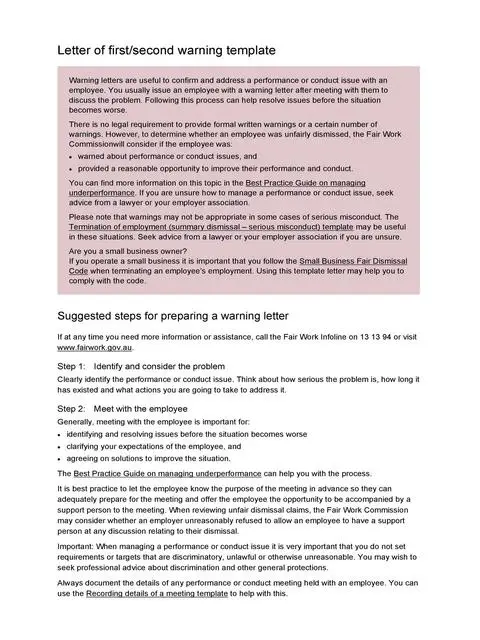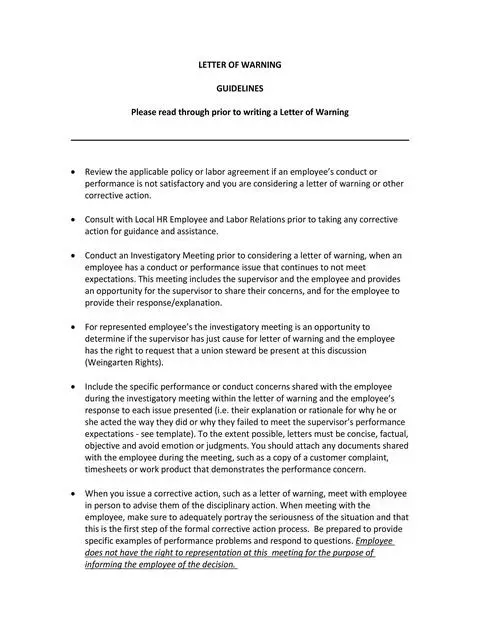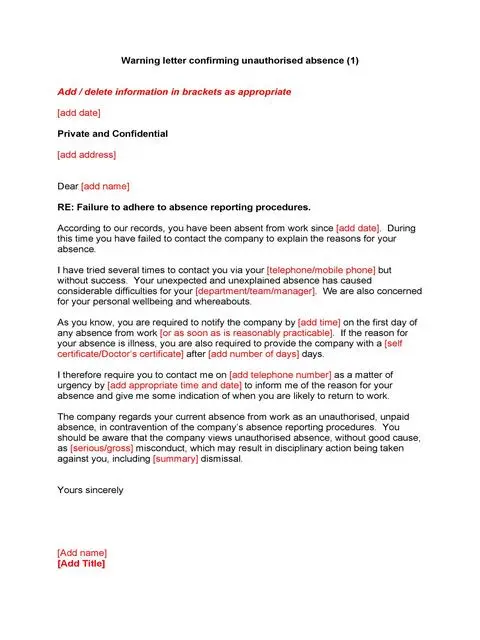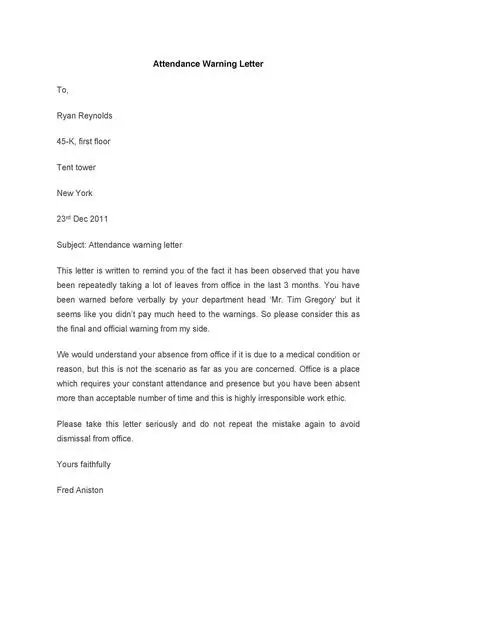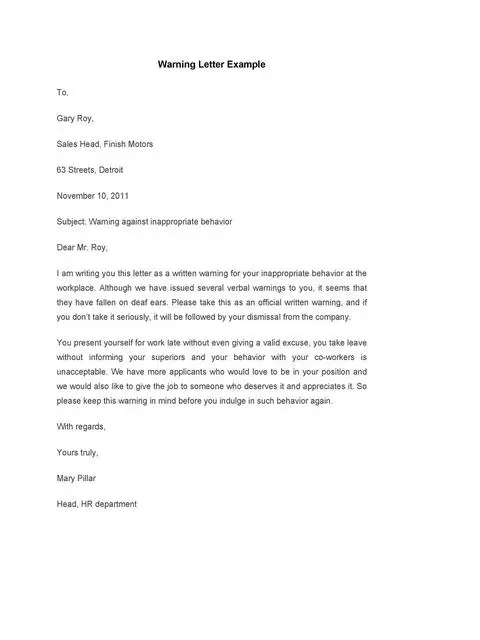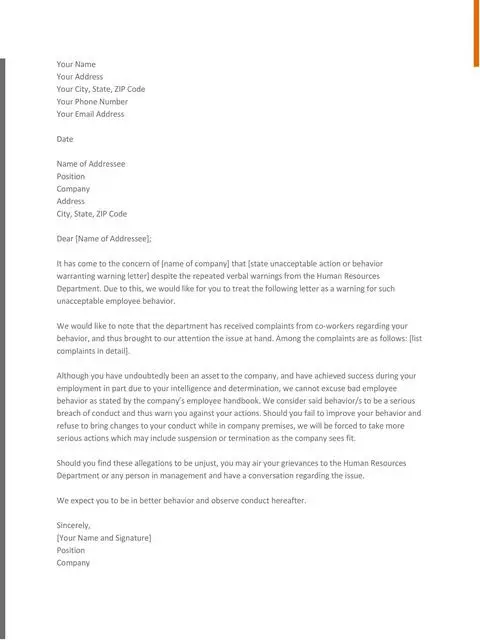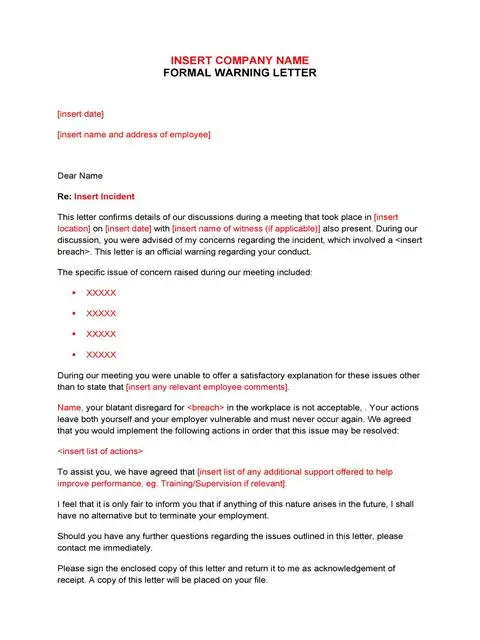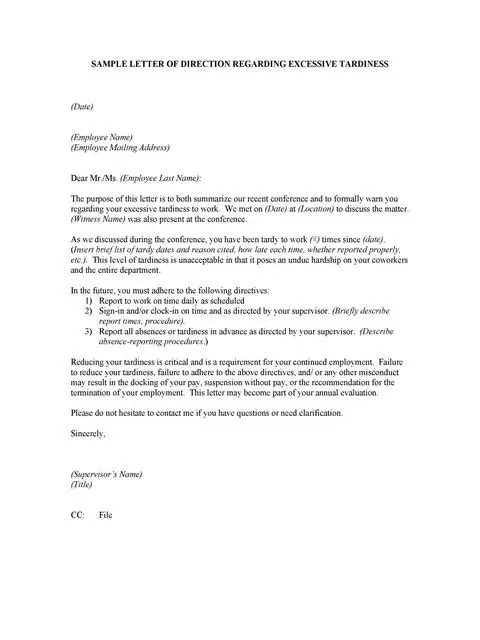An employee warning letter, also called an employee termination letter, is a formal letter that an employer issue to tell an employee that their employment has been terminated. The main purpose of such a letter is basically to let the worker know of their bad performance, unacceptable behavior, or other actions.
It is written in support of the employee’s right to an appeal, as well as their right to take legal action if wronged. If this type of letter exists, it does not exist to just be thrown in a drawer and forgotten about; it is kept in files for future use. It needs to be kept current and accurate so that employers know what to expect when there is an inappropriate action or request of the employee.
Employee Warning Letter
An employee warning letter is a formal notification from an employer to an employee that they have observed behavior that is in violation of company policy. Example of example employee warning letter template in various doc and pdf format, for absolutely free download. A well-worded, clear and official final warning is the best possible warning given in the workplace.
How to Write an Employee Warning Letter
They are several tips on how to make an formal employee warning letter – avoid these mistakes in your letter :
- understand your employer’s reason for issuing the letter
So, how do you write one? First, you must understand your employer’s reason for issuing the letter. There are many different situations that could lead to disciplinary actions or warnings, so the process varies depending on the situation. For example, a warning may be issued because of improper filing of time cards, a lack of attendance at work, or even harassment. Each of these situations requires a different employee warning letter format, so you need to know where to look to find one that fits the situation best.
- you need to write a very compelling letter, explaining the circumstances that led up to the warnings or disciplinary actions that are being placed against the employee.
Do not take this too lightly; your employer will be looking for a few things from you in this letter. You need to explain what the employee did to deserve the warning or reprimand, as well as how these actions relate to company policy or company values. You should also have a few ways in which you can appeal the reprimand or decision, especially when there are no appeals policies clearly in place. Your signature, as the signatory to the letter, is important here.
- customize it for your specific situation.
Once you have your Employee warning Letter ready, you may need to customize it for your specific situation. Your employer may only require that you use specific fonts, slogans, or even have certain formats to help reinforce the information provided in your letter. The key is to make sure that your customized letter has all the elements that will make it effective and easy to read.
As part of your training for creating your employee warning letter, you should learn how to write a well-crafted letter that addresses the specific situation. Most companies will want you to provide the details of what happened, both verbally and in writing.
- include a brief explanation of your actions in the warning
They will also want to know how the situation has affected the employees, both positively and negatively. You may want to include a brief explanation of your actions in the reprimand or warning, as this will show why the warning or reprimand was issued.
You can emphasize any positive actions taken by the company and point out any negative actions as well. Be careful not to use the same “I” too many times in your letter, as this could be construed as repetitive and overbearing.
Most employee warning letters also include information on what is expected of the employee after you have given the final verbal reprimand or warning. This is very important, as you want to ensure that you don’t end up issuing another reprimand or warning to someone else in the future that could lead to additional discipline from your manager. Be sure to mention to the person receiving the punishment that they must report to you within a specific time frame or face severe penalties. Failure to follow this advice can result in additional actions from you that can range from termination to loss of employment.
- Find that the actual words in the employee warning letter
You may also find that the actual words in the employee warning letter are very important. Avoid using extremely strong language when describing the events leading up to the reprimand or warning. Instead, focus your words on the facts, offering details that explain exactly what happened.
For example, if you were told by your supervisor that your tardiness was directly related to your performance level, rather than a lack of motivation, mention this in your letter. This detail will demonstrate that you are in fact doing what you are supposed to do, which is improve your performance.
- Do not repeat the same mistakes in your employee warning.
Finally, it is important that you do not repeat the same mistakes in your employee warning letter template that you did in your employee handbook. For example, if your handbook ended with a section detailing what you are expected to do in specific situations, make sure that your letter includes that specific section as well.
Employee Warning Letter Template
Official Employee Warning Letter
The last thing that anyone wants to read is an employee handbook with vague wording, only to find out that you failed to adhere to it in certain situations. Therefore, take extra care to ensure that you keep your warning and reprimand words clear and concise, using language that accurately matches the situation you are describing.
Following these basic rules should help ensure that you are sending out accurate employee handbooks and official employee warning letter.
Reasons an Employee Warning Letter Template Is Needed
They are some important reasons an employee warning letter template is needed :
- Reminded for good performance or poor performance.
An employee should always be reminded of what is expected of them at all times – good performance or poor performance. It would be an irony if this golden rule were not followed even after receiving a warning letter. Most employers understand that they are treading a fine line with employees who show no interest in following the rules. An official, written letter is the best way to deal with this issue and maintain a positive working environment.
- Official notification from the HR Department of the company regarding termination of the employee
In some cases, an employee warning letter template may be accompanied by an official notification from the HR Department of the company regarding termination of the employee. This is required as per the Labor Code. An employee has certain rights when it comes to written warnings and termination lawsuits. They are entitled to be heard as well as to be informed of their rights to any other facts that may be discovered during an investigation. The right to be informed of their rights cannot be denied by the employer, nor by the employee, even in cases where there is a misunderstanding of any facts at hand.
- The erasure of an employee’s salary during an investigation
In addition, there is also the matter of the erasure of an employee’s salary during an investigation. An employee warning letter template can help you deal with this as well. There are certain clauses in different labor codes that specifically deal with this. In most cases, this will be covered under the Fair Labor Standards Act. When writing your letter, remember to be brief and to the point. There are several employees who find writing very hard and would benefit from templates for both formal and informal notices.
- To consider in a letter is the length of the final message.
The next factor to consider in a letter is the length of the final message. An employee warning letter should make the employer have enough time to conduct an investigation and see if a case of harassment has indeed taken place. If not, the final note should state that the employer has received the complaint and is now reviewing the matter. The employee should be given the date on which this review will take place as well as any updates that have been made since the initial complaint.
Apart from the dates, it is important to include any official documentation as proof of the matter. The document that can be provided includes official notice from the human resources department of the company and any official document that has been issued by the Labor Department regarding this matter. Most employers know that official documents are needed for court proceedings. Therefore, these statements are usually found in a separate letter.
- Written warning is the statement that states why the employer took action and what steps were taken in response to the complaints.
The final part of a written warning is the statement that states why the employer took action and what steps were taken in response to the complaints. An employee warning letter template will normally contain this section. However, it is not necessary to include every single reason.
- A clear and concise statement is all that is needed in this section.
This will allow the employee to see that their behavior has consequences. Many employers find that this section helps them reduce illegal behavior since many employees do not realize they are breaking the law.
Employee warning letter for poor performance
They are use to reminded for poor performance.
Employee warning letter for misconduct
They are used to employee warning letter for misconduct
Employee final warning letter
This is used for employee final warning letter
Employee formal warning letter
This is Used for formal warning letter
In addition, this section lets employees know that their actions are not taken lightly and that legal action will be taken. It also lets employees know that the company values their opinions and will not tolerate discrimination of any sort. Most importantly, it lets employees know that their actions will have consequences and hopefully encourage them to alter their behavior patterns so that they are not subjected to legal actions.
